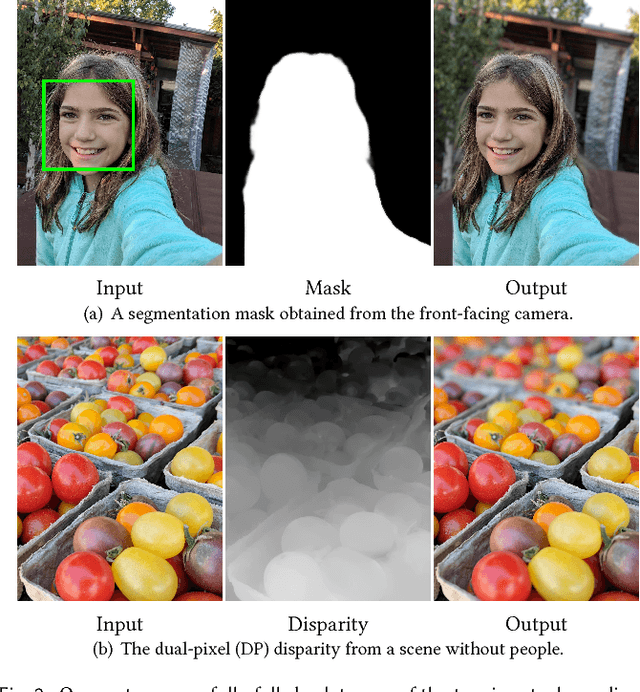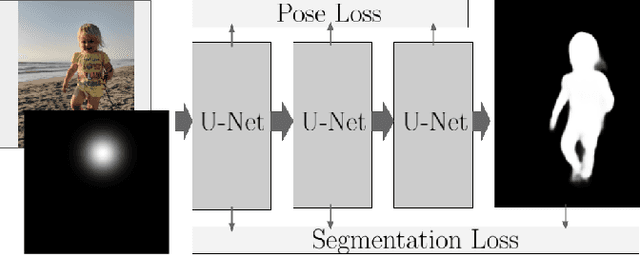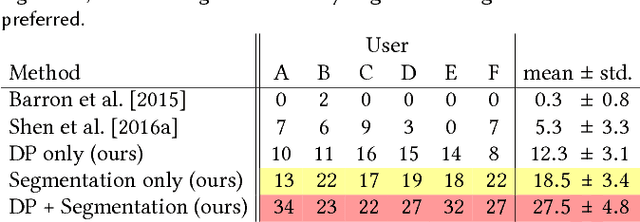Nori Kanazawa
Training-Free Neural Matte Extraction for Visual Effects
Jun 29, 2023
Abstract:Alpha matting is widely used in video conferencing as well as in movies, television, and social media sites. Deep learning approaches to the matte extraction problem are well suited to video conferencing due to the consistent subject matter (front-facing humans), however training-based approaches are somewhat pointless for entertainment videos where varied subjects (spaceships, monsters, etc.) may appear only a few times in a single movie -- if a method of creating ground truth for training exists, just use that method to produce the desired mattes. We introduce a training-free high quality neural matte extraction approach that specifically targets the assumptions of visual effects production. Our approach is based on the deep image prior, which optimizes a deep neural network to fit a single image, thereby providing a deep encoding of the particular image. We make use of the representations in the penultimate layer to interpolate coarse and incomplete "trimap" constraints. Videos processed with this approach are temporally consistent. The algorithm is both very simple and surprisingly effective.
Zoom-to-Inpaint: Image Inpainting with High Frequency Details
Dec 17, 2020



Abstract:Although deep learning has enabled a huge leap forward in image inpainting, current methods are often unable to synthesize realistic high-frequency details. In this paper, we propose applying super resolution to coarsely reconstructed outputs, refining them at high resolution, and then downscaling the output to the original resolution. By introducing high-resolution images to the refinement network, our framework is able to reconstruct finer details that are usually smoothed out due to spectral bias - the tendency of neural networks to reconstruct low frequencies better than high frequencies. To assist training the refinement network on large upscaled holes, we propose a progressive learning technique in which the size of the missing regions increases as training progresses. Our zoom-in, refine and zoom-out strategy, combined with high-resolution supervision and progressive learning, constitutes a framework-agnostic approach for enhancing high-frequency details that can be applied to other inpainting methods. We provide qualitative and quantitative evaluations along with an ablation analysis to show the effectiveness of our approach, which outperforms state-of-the-art inpainting methods.
Synthetic Depth-of-Field with a Single-Camera Mobile Phone
Jun 11, 2018



Abstract:Shallow depth-of-field is commonly used by photographers to isolate a subject from a distracting background. However, standard cell phone cameras cannot produce such images optically, as their short focal lengths and small apertures capture nearly all-in-focus images. We present a system to computationally synthesize shallow depth-of-field images with a single mobile camera and a single button press. If the image is of a person, we use a person segmentation network to separate the person and their accessories from the background. If available, we also use dense dual-pixel auto-focus hardware, effectively a 2-sample light field with an approximately 1 millimeter baseline, to compute a dense depth map. These two signals are combined and used to render a defocused image. Our system can process a 5.4 megapixel image in 4 seconds on a mobile phone, is fully automatic, and is robust enough to be used by non-experts. The modular nature of our system allows it to degrade naturally in the absence of a dual-pixel sensor or a human subject.
Towards Accurate Multi-person Pose Estimation in the Wild
Apr 14, 2017



Abstract:We propose a method for multi-person detection and 2-D pose estimation that achieves state-of-art results on the challenging COCO keypoints task. It is a simple, yet powerful, top-down approach consisting of two stages. In the first stage, we predict the location and scale of boxes which are likely to contain people; for this we use the Faster RCNN detector. In the second stage, we estimate the keypoints of the person potentially contained in each proposed bounding box. For each keypoint type we predict dense heatmaps and offsets using a fully convolutional ResNet. To combine these outputs we introduce a novel aggregation procedure to obtain highly localized keypoint predictions. We also use a novel form of keypoint-based Non-Maximum-Suppression (NMS), instead of the cruder box-level NMS, and a novel form of keypoint-based confidence score estimation, instead of box-level scoring. Trained on COCO data alone, our final system achieves average precision of 0.649 on the COCO test-dev set and the 0.643 test-standard sets, outperforming the winner of the 2016 COCO keypoints challenge and other recent state-of-art. Further, by using additional in-house labeled data we obtain an even higher average precision of 0.685 on the test-dev set and 0.673 on the test-standard set, more than 5% absolute improvement compared to the previous best performing method on the same dataset.
 Add to Chrome
Add to Chrome Add to Firefox
Add to Firefox Add to Edge
Add to Edge